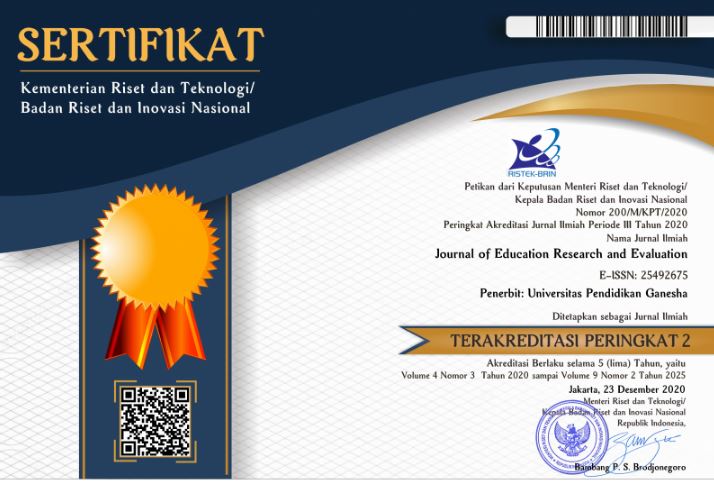The Effect of ‘Power’ as an Instructional Writing Strategy on Students’ Writing Skill Across Gender
DOI:
https://doi.org/10.23887/jere.v4i1.23960Kata Kunci:
Gender differences, Instructional writing strategy, POWER, Writing skillAbstrak
The study aimed at: (1) investigating the effect of POWER as an instructional writing strategy on students’ writing skill; (2) analyzing the different effect of POWER across gender; and (3) analyzing problems of writing faced by the students. The explanatory design was applied in this study. A writing post-test was used to obtain the data and were analyzed using One-Way ANOVA. The findings of the study revealed that (1) there was a significant effect of POWER on students’ writing skill: p = .001 with a large effect size (eta = .17); (2) there was a significant difference on the effect of POWER on the students’ writing skill across gender: p = .013 with a large effect size (eta = .18); and (3) the males struggled in editing and revising rather than females. Then, those resulted in the differences quality of their writing, in which point female participants surpassed the males. Therefore, teachers are expected to implement POWER as one of their variants in EFL writing instruction
Referensi
Adams, A. M., & Simmons, F. R. (2019). Exploring individual and gender differences in early writing performance. Reading and Writing, 32(2), 235–263. https://doi.org/10.1007/s11145-018-9859-0
Bakar, N. A., Awal, N. M., & Jalaluddin, N. H. (2011). Investigating Malay language writing proficiency level among upper secondary school students. GEMA Online Journal of Language Studies, 11(2), 39–51.
Balta, E. E. (2018). The Relationships Among Writing Skills , Writing Anxiety and Metacognitive Awareness. Journal of Education and Learning, 7(3), 233–241. https://doi.org/10.5539/jel.v7n3p233
Bijami, M., Kashef, S. H., & Khaksari, M. (2013). Gender differences and writing performance: A brief review. International Journal of Education and Literacy Studies, 1(2), 8–11. https://doi.org/10.7575/aiac.ijels.v.1n.2p.8
Brown, H. D. (2003). Language Assessment: Principles and Classroom Practices. https://doi.org/10.1017/CBO9781107415324.004
Chamot, A. U. (2005). Language learning strategy instruction: Current issues and research. Annual Review of Applied Linguistics, 25(2005), 112–130. https://doi.org/10.1017/S0267190505000061
Chen, Y. (2011). Study of the writing strategies used by Chinese non-English majors. Theory and Practice in Language Studies, 1(3), 245–251. https://doi.org/10.4304/tpls.1.3.245-251
Chung, L. Y., & Chang, R. C. (2017). The effect of gender on motivation and student achievement in digital game-based learning: A case study of a contented-based classroom. Eurasia Journal of Mathematics, Science and Technology Education, 13(6), 2309–2327. https://doi.org/10.12973/EURASIA.2017.01227A
Cornett, H. E. (2014). Gender differences in syntactic development among English speaking adolescents. Inquiries, 6(3), 18–29.
Creswell, J. W. (2012). Educational Research: Planning, Conducting and Evaluating Quantitative and Qualitative Research (4th ed.). Boston: Pearson Education, Inc.
Englert, C. S., Raphael, T. E., Anderson, L. M., Anthony, H. M., & Stevens, D. D. (1991). Making Strategies and Self-Talk Visible: Writing Instruction in Regular and Special Education Classrooms. American Educational Research Journal, 28(2), 337–372.
Fidelia, O. A. (2015). Gender in Students’ Achievement in English Essay Writing Using Collaborative Instructional Strategy. International Journal of English Language Education, 3(1), 85–91. https://doi.org/10.5296/ijele.v3i1.6763
Hadjar, A., Krolak-Schwerdt, S., Priem, K., & Glock, S. (2014). Gender and educational achievement. Educational Research, 56(2), 117–125. https://doi.org/10.1080/00131881.2014.898908
Harmer, J. (2004). How to Teach Writing. London: Longman.
Harmer, J. (2007). The Practice of English Language Teaching. London: Longman.
Ishikawa, Y. (2015). Gender differences in vocabulary use in essay writing by university students. Procedia - Social and Behavioral Sciences, 192(2), 593–600. https://doi.org/10.1016/j.sbspro.2015.06.078
Istianah, T. N. (2016). The Effectiveness of POWER (Plan, Organize, Write, Edit, and Revise) Strategy to Teach Writing viewed from Students’ Creativity (An Experimental Study at SMA Al-Abidin Bilingual Boarding School in the Academic Year of 2016/2017. Paedagogia, 19(2), 128–139.
Karim, R. A., & Abu, A. G. (2017). Brainstorming approach and mind mapping in writing activity. In Proceedings of the 1st English Education International Conference, 1(2), 423–429.
Kusumaningputri, R., Ningsih, T. A., & Wisasongko, W. (2018). Second Language Writing Anxiety of Indonesian EFL Students. Lingua Cultura, 12(4), 357–362. https://doi.org/10.21512/lc.v12i4.4268
Lakoff, R. (1973). Language and Woman ’ s Place. Cambridge University Press, 2(1), 45–80. https://doi.org/10.1017/S0047404500000051
Langan, J. (2008). English Skills with Readings (7th ed.). Singapore: McGraw-Hill Education.
Lincoln, F., & Idris, A. (2014). Teaching the writing process as a first and second language revisited: Are they the same? Journal of International Education Research, 11(2), 119–124. Retrieved from http://eric.ed.gov/?q=%22writing%22&pg=2&id=EJ1060041
Liu, X. (2018). Research on the application of “Tree Analysis Diagram” to the teaching of English argumentative writing of the Chinese EFL learners. English Language Teaching, 11(3), 137–152. https://doi.org/10.5539/elt.v11n3p137
Lorena, C., & Sadiku, M. (2015). The Importance of Four Skills Reading, Speaking, Writing, Listening in a Lesson Hour. European Journal of Language and Literature Studies, 1(1), 29–31.
Marc Jackman, W., & Morrain-Webb, J. (2019). Exploring gender differences in achievement through student voice: critical insights and analyses. Cogent Education, 6, 1–13. https://doi.org/10.1080/2331186x.2019.1567895
Mastan, M. E., Maarof, N., & Embi, M. A. (2017). The effect of writing strategy instruction on ESL intermediate proficiency learners ’ writing performance. Journal of Educational Research and Review, 5(5), 71–78.
Maznun, D. B. M., Monsefi, R., & Nimehchisalem, V. (2017). Undergraduate ESL students’ difficulties in writing the introduction for research reports. Advances in Language and Literary Studies, 8(1), 9–16. https://doi.org/10.7575/aiac.alls.v.8n.1p.9
Mohseniasl, F. (2014). Examining the effect of strategy instruction on writing apprehension and writing achievement of EFL learners. Theory and Practice in Language Studies, 4(4), 811–817. https://doi.org/10.4304/tpls.4.4.811-817
Muhari, Widiati, U., & Furaidah. (2017). Implementing POWER Strategy Combined with The Animated Film to Improve The Writing Ability in Narrative Text for Junior High School. Jurnal Pendidikan Humaniora, 5(3), 104–116.
Naglieri, J. A., & Rojahn, J. (2001). Gender differences in Planning, Attention, Simultaneous, and Successive (PASS) cognitive processes and achievement. Journal of Educational Psychology, 93(2), 430–437. https://doi.org/10.1037/0022-0663.93.2.430
Ning, H., Dai, X., & Zhang, F. (2010). On gender difference in English language and its causes. Asian Social Science, 6(2), 126–130. https://doi.org/10.5539/ass.v6n2p126
Nunan, D. (2003). Practical English Language Teaching (1st ed.). Singapore: McGraw-Hill.
Oshima, A., & Hogue, A. (2006). Writing Academic English (4th ed.). New York: Pearson Longman.
Richards, J. C. (1990). The Language Teaching Matrix. Cambridge: Cambridge University Press.
Rizqiya, R. S., Pamungkas, M. Y., & Inayah, R. (2017). The use of POWER learning as a learning strategy to improve students writing competency. Jurnal Bahasa Dan Sastra, 11(2), 253–262.
Sterkel, K. S. (1988). The Relationship Between Gender and Writing Style in Business Communications. , 25(4), 17–38. doi:10.1177/002194368802500402. Journal of Business Communication, 24(5), 17–38.
Suganob-nicolau, M. F., & Sukamto, K. E. (2016). Gender differences in writing complex sentences : A case study of Indonesian EFL students. Indonesian Journal of English Language Teaching, 11(May), 69–80.
Suriyanti, S., & Yaacob, A. (2016). Exploring teacher strategies in teaching descriptive writing in indonesia. Malaysian Journal of Learning and Instruction, 13(2), 71–95.
Tosuncuoğlu, I. (2018). Forming a well-organized writing activities. Journal of Education and Training Studies, 6(6), 122–127. https://doi.org/10.11114/jets.v6i6.3111
Wang, Z. (2014). The Application of Process Writing in Chinese EFL Classrooms in Higher Education. International Journal of English Linguistics, 4(3), 88–95. https://doi.org/10.5539/ijel.v4n3p88
Xia, X. (2013). Gender differences in using language. Theory and Practice in Language Studies, 3(8), 1485–1489. https://doi.org/10.4304/tpls.3.8.1485-1489
Yuliana, W. (2015). Teaching writing by combining POWER (Plan, Organize, Write, Edit, Revise) and T-chart strategy. TELL-US Journal, 3(1), 45–54.
Unduhan
Diterbitkan
Cara Mengutip
Terbitan
Bagian
Lisensi
Authors who publish with the Journal of Evaluation and Research in Education (JERE) agree to the following terms:
- Authors retain copyright and grant the journal the right of first publication with the work simultaneously licensed under a Creative Commons Attribution License (CC BY-SA 4.0) that allows others to share the work with an acknowledgment of the work's authorship and initial publication in this journal.
- Authors are able to enter into separate, additional contractual arrangements for the non-exclusive distribution of the journal's published version of the work (e.g., post it to an institutional repository or publish it in a book), with an acknowledgment of its initial publication in this journal.
- Authors are permitted and encouraged to post their work online (e.g., in institutional repositories or on their website) prior to and during the submission process, as it can lead to productive exchanges, as well as earlier and greater citation of published work. (See The Effect of Open Access)











